Holmes Institute HC1010 Accounting for Business Assignment T1 2019
VerifiedAdded on 2023/04/03
|7
|1174
|228
Homework Assignment
AI Summary
This assignment solution for Accounting for Business (HC1010) addresses financial statement analysis and accounting principles. Part A focuses on liquidity and operational performance using ratios such as current ratio, quick ratio, accounts receivable turnover, and inventory turnover, comparing 2018 and 2019 data. Part B explores the definition of revenue according to AASB 118, applying it to scenarios involving a software company, Green Apple, and determining what constitutes revenue versus other income. Part C involves a loan and business valuation scenario, comparing two companies (XYZ and ABC) based on their financial ratios, particularly current ratio, and considering how changes in liabilities affect valuation. The assignment provides a detailed analysis of financial performance, revenue recognition, and valuation methodologies.
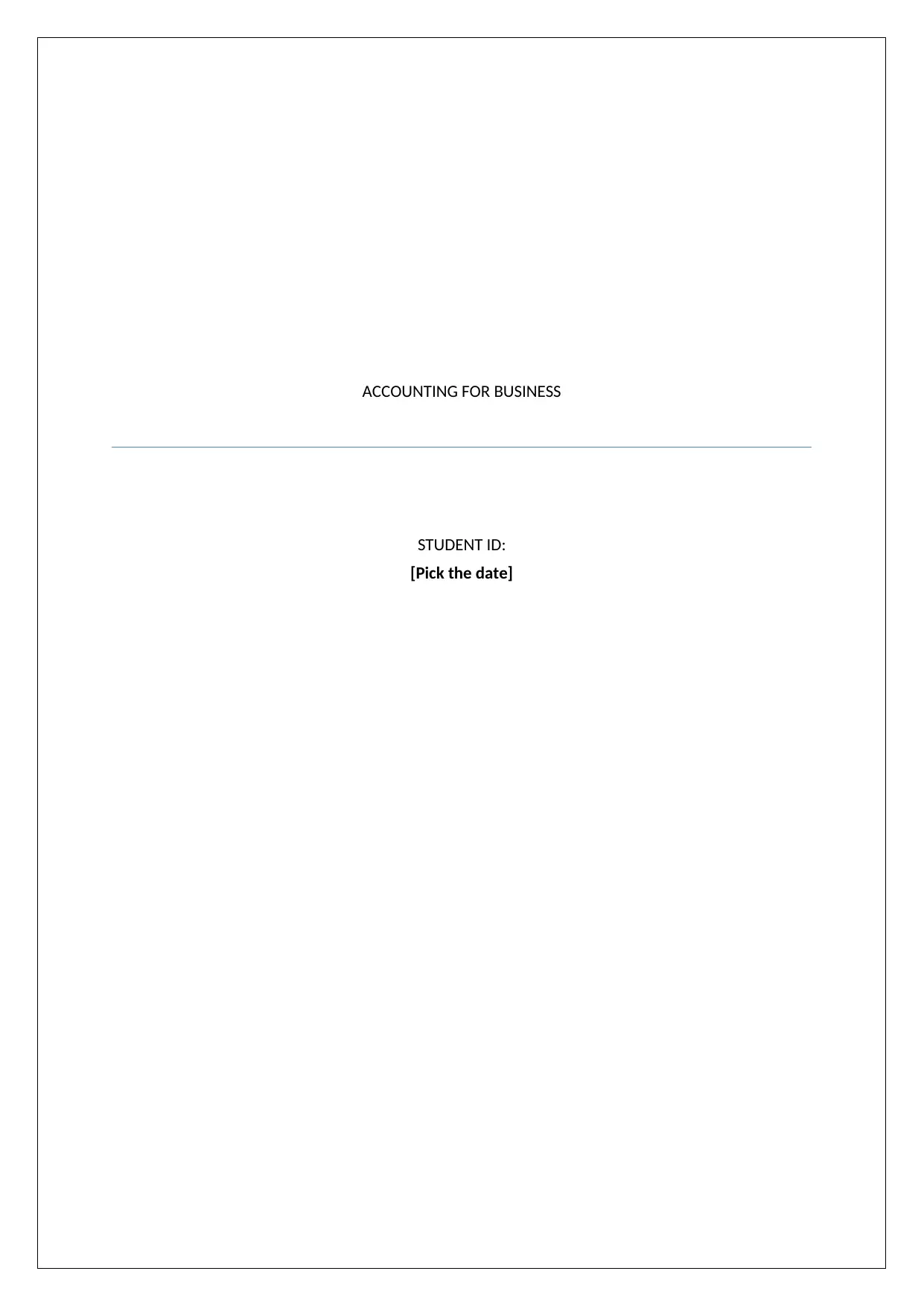
ACCOUNTING FOR BUSINESS
STUDENT ID:
[Pick the date]
STUDENT ID:
[Pick the date]
Paraphrase This Document
Need a fresh take? Get an instant paraphrase of this document with our AI Paraphraser
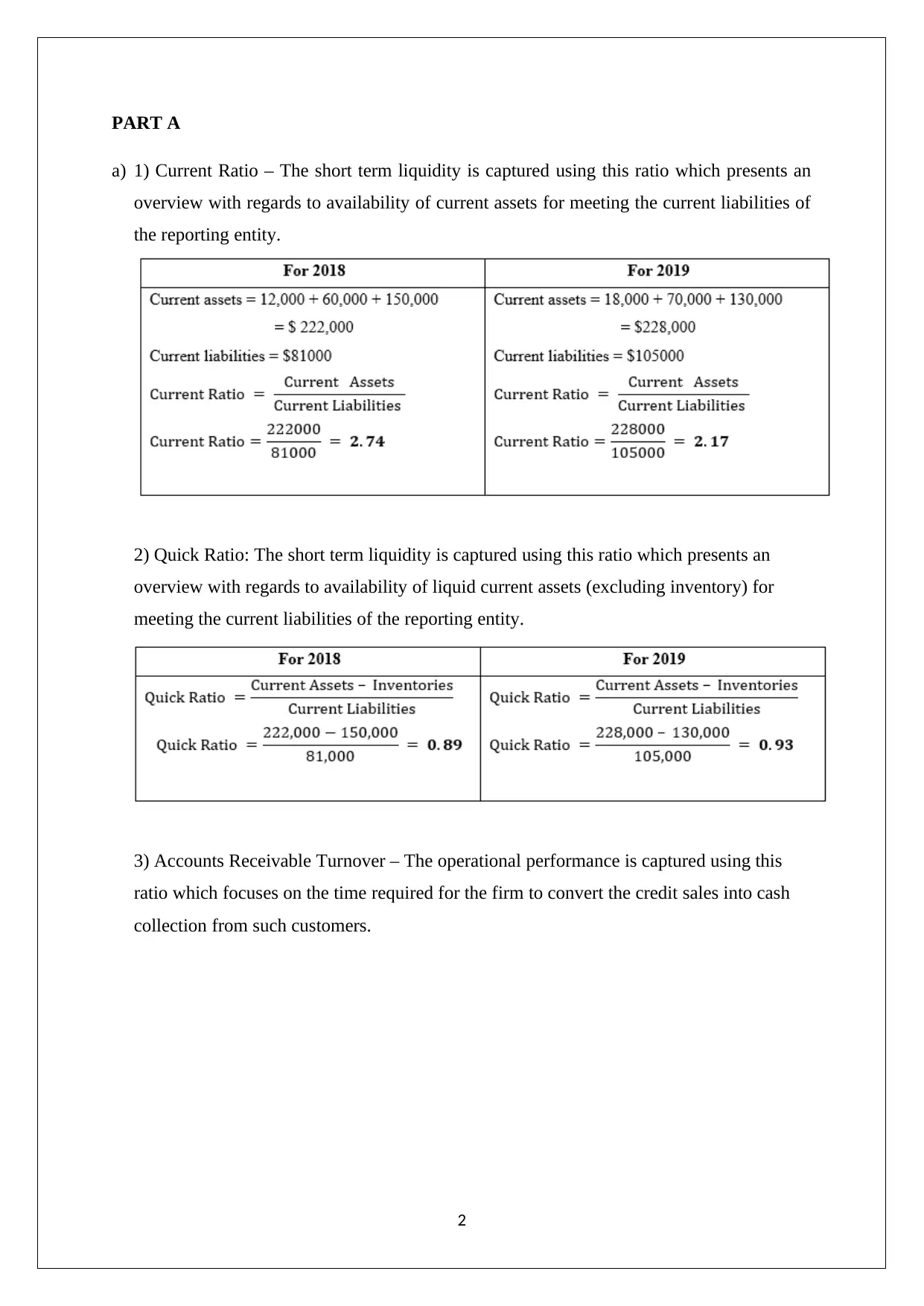
PART A
a) 1) Current Ratio – The short term liquidity is captured using this ratio which presents an
overview with regards to availability of current assets for meeting the current liabilities of
the reporting entity.
2) Quick Ratio: The short term liquidity is captured using this ratio which presents an
overview with regards to availability of liquid current assets (excluding inventory) for
meeting the current liabilities of the reporting entity.
3) Accounts Receivable Turnover – The operational performance is captured using this
ratio which focuses on the time required for the firm to convert the credit sales into cash
collection from such customers.
2
a) 1) Current Ratio – The short term liquidity is captured using this ratio which presents an
overview with regards to availability of current assets for meeting the current liabilities of
the reporting entity.
2) Quick Ratio: The short term liquidity is captured using this ratio which presents an
overview with regards to availability of liquid current assets (excluding inventory) for
meeting the current liabilities of the reporting entity.
3) Accounts Receivable Turnover – The operational performance is captured using this
ratio which focuses on the time required for the firm to convert the credit sales into cash
collection from such customers.
2
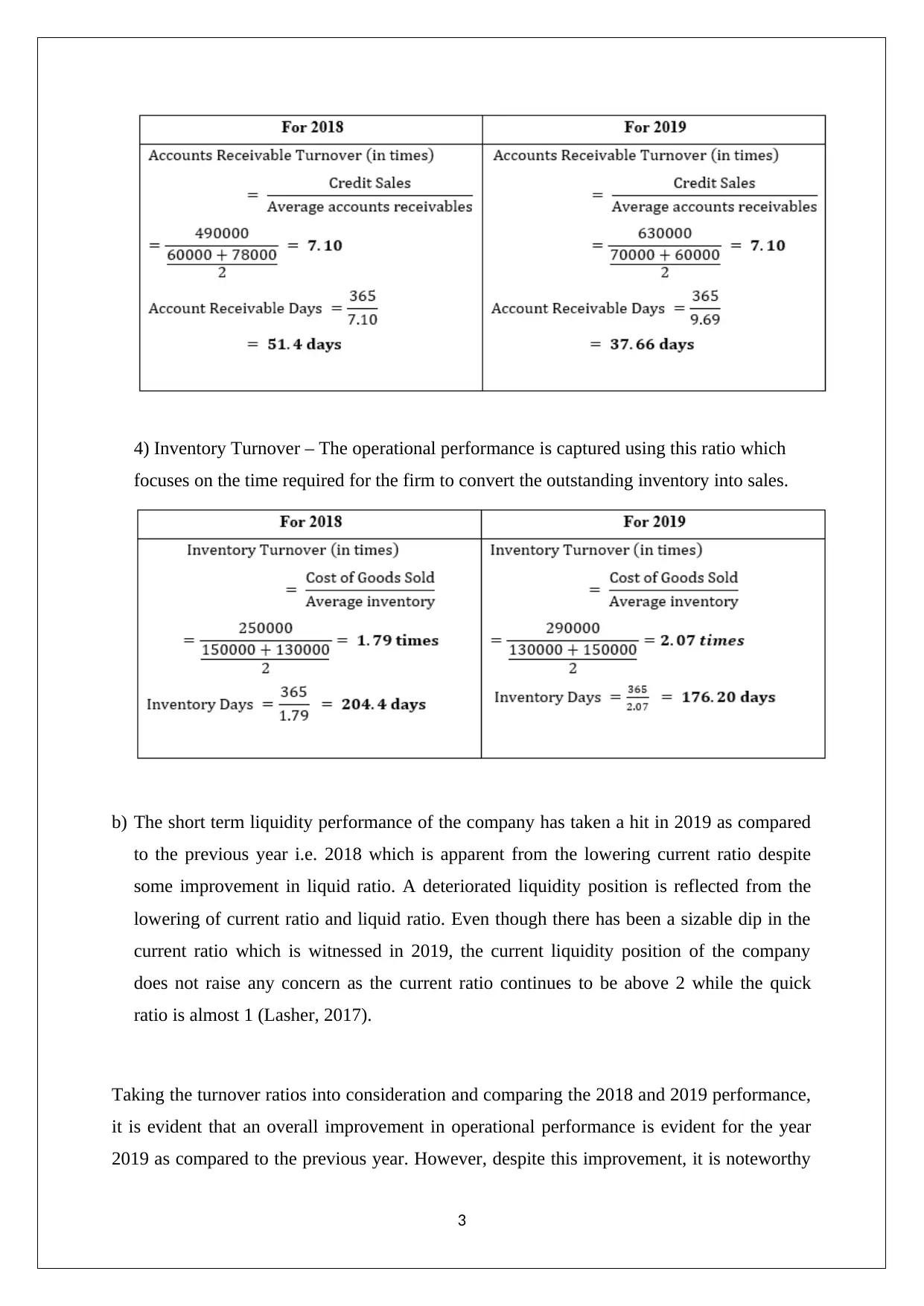
4) Inventory Turnover – The operational performance is captured using this ratio which
focuses on the time required for the firm to convert the outstanding inventory into sales.
b) The short term liquidity performance of the company has taken a hit in 2019 as compared
to the previous year i.e. 2018 which is apparent from the lowering current ratio despite
some improvement in liquid ratio. A deteriorated liquidity position is reflected from the
lowering of current ratio and liquid ratio. Even though there has been a sizable dip in the
current ratio which is witnessed in 2019, the current liquidity position of the company
does not raise any concern as the current ratio continues to be above 2 while the quick
ratio is almost 1 (Lasher, 2017).
Taking the turnover ratios into consideration and comparing the 2018 and 2019 performance,
it is evident that an overall improvement in operational performance is evident for the year
2019 as compared to the previous year. However, despite this improvement, it is noteworthy
3
focuses on the time required for the firm to convert the outstanding inventory into sales.
b) The short term liquidity performance of the company has taken a hit in 2019 as compared
to the previous year i.e. 2018 which is apparent from the lowering current ratio despite
some improvement in liquid ratio. A deteriorated liquidity position is reflected from the
lowering of current ratio and liquid ratio. Even though there has been a sizable dip in the
current ratio which is witnessed in 2019, the current liquidity position of the company
does not raise any concern as the current ratio continues to be above 2 while the quick
ratio is almost 1 (Lasher, 2017).
Taking the turnover ratios into consideration and comparing the 2018 and 2019 performance,
it is evident that an overall improvement in operational performance is evident for the year
2019 as compared to the previous year. However, despite this improvement, it is noteworthy
3
⊘ This is a preview!⊘
Do you want full access?
Subscribe today to unlock all pages.

Trusted by 1+ million students worldwide
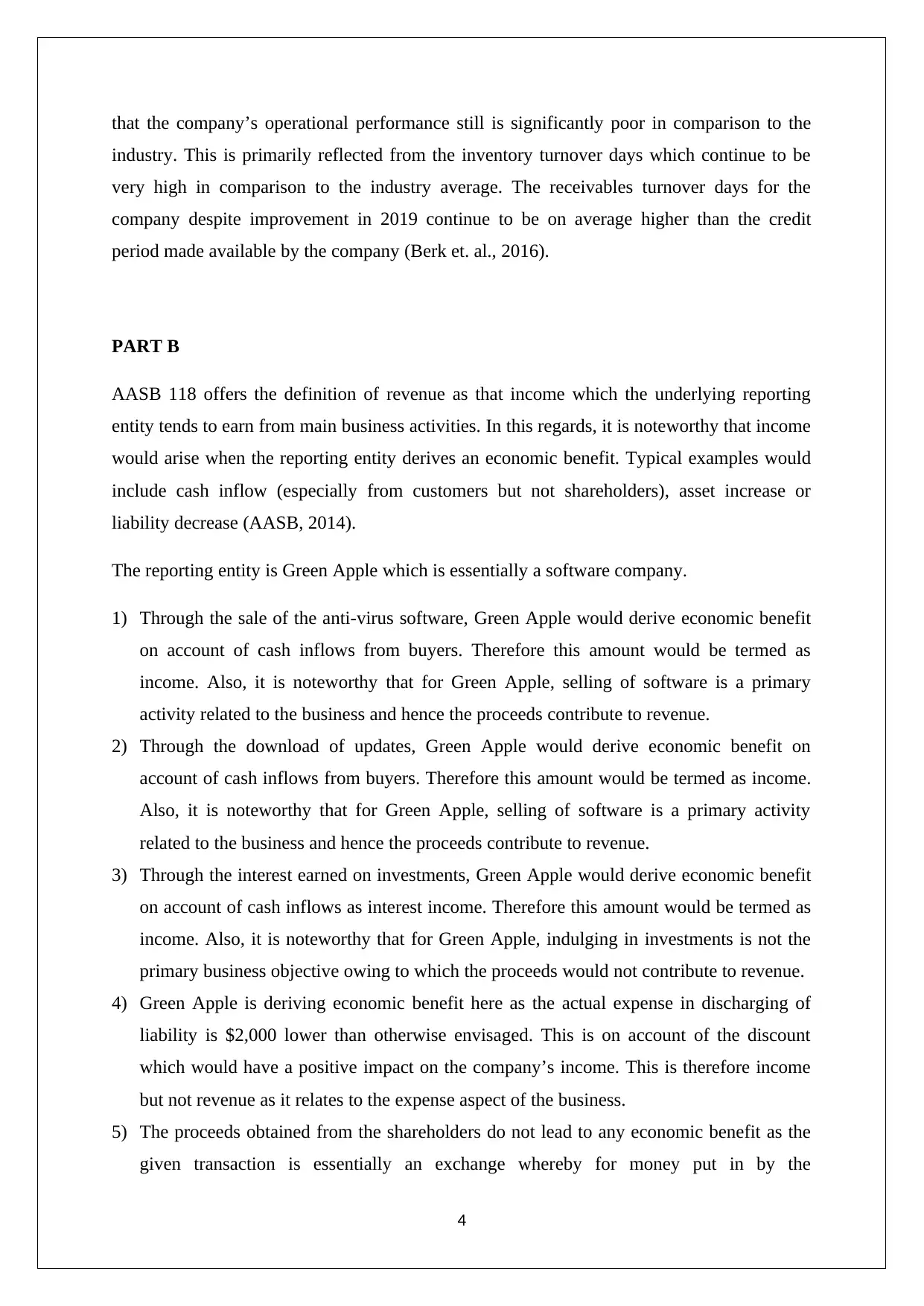
that the company’s operational performance still is significantly poor in comparison to the
industry. This is primarily reflected from the inventory turnover days which continue to be
very high in comparison to the industry average. The receivables turnover days for the
company despite improvement in 2019 continue to be on average higher than the credit
period made available by the company (Berk et. al., 2016).
PART B
AASB 118 offers the definition of revenue as that income which the underlying reporting
entity tends to earn from main business activities. In this regards, it is noteworthy that income
would arise when the reporting entity derives an economic benefit. Typical examples would
include cash inflow (especially from customers but not shareholders), asset increase or
liability decrease (AASB, 2014).
The reporting entity is Green Apple which is essentially a software company.
1) Through the sale of the anti-virus software, Green Apple would derive economic benefit
on account of cash inflows from buyers. Therefore this amount would be termed as
income. Also, it is noteworthy that for Green Apple, selling of software is a primary
activity related to the business and hence the proceeds contribute to revenue.
2) Through the download of updates, Green Apple would derive economic benefit on
account of cash inflows from buyers. Therefore this amount would be termed as income.
Also, it is noteworthy that for Green Apple, selling of software is a primary activity
related to the business and hence the proceeds contribute to revenue.
3) Through the interest earned on investments, Green Apple would derive economic benefit
on account of cash inflows as interest income. Therefore this amount would be termed as
income. Also, it is noteworthy that for Green Apple, indulging in investments is not the
primary business objective owing to which the proceeds would not contribute to revenue.
4) Green Apple is deriving economic benefit here as the actual expense in discharging of
liability is $2,000 lower than otherwise envisaged. This is on account of the discount
which would have a positive impact on the company’s income. This is therefore income
but not revenue as it relates to the expense aspect of the business.
5) The proceeds obtained from the shareholders do not lead to any economic benefit as the
given transaction is essentially an exchange whereby for money put in by the
4
industry. This is primarily reflected from the inventory turnover days which continue to be
very high in comparison to the industry average. The receivables turnover days for the
company despite improvement in 2019 continue to be on average higher than the credit
period made available by the company (Berk et. al., 2016).
PART B
AASB 118 offers the definition of revenue as that income which the underlying reporting
entity tends to earn from main business activities. In this regards, it is noteworthy that income
would arise when the reporting entity derives an economic benefit. Typical examples would
include cash inflow (especially from customers but not shareholders), asset increase or
liability decrease (AASB, 2014).
The reporting entity is Green Apple which is essentially a software company.
1) Through the sale of the anti-virus software, Green Apple would derive economic benefit
on account of cash inflows from buyers. Therefore this amount would be termed as
income. Also, it is noteworthy that for Green Apple, selling of software is a primary
activity related to the business and hence the proceeds contribute to revenue.
2) Through the download of updates, Green Apple would derive economic benefit on
account of cash inflows from buyers. Therefore this amount would be termed as income.
Also, it is noteworthy that for Green Apple, selling of software is a primary activity
related to the business and hence the proceeds contribute to revenue.
3) Through the interest earned on investments, Green Apple would derive economic benefit
on account of cash inflows as interest income. Therefore this amount would be termed as
income. Also, it is noteworthy that for Green Apple, indulging in investments is not the
primary business objective owing to which the proceeds would not contribute to revenue.
4) Green Apple is deriving economic benefit here as the actual expense in discharging of
liability is $2,000 lower than otherwise envisaged. This is on account of the discount
which would have a positive impact on the company’s income. This is therefore income
but not revenue as it relates to the expense aspect of the business.
5) The proceeds obtained from the shareholders do not lead to any economic benefit as the
given transaction is essentially an exchange whereby for money put in by the
4
Paraphrase This Document
Need a fresh take? Get an instant paraphrase of this document with our AI Paraphraser
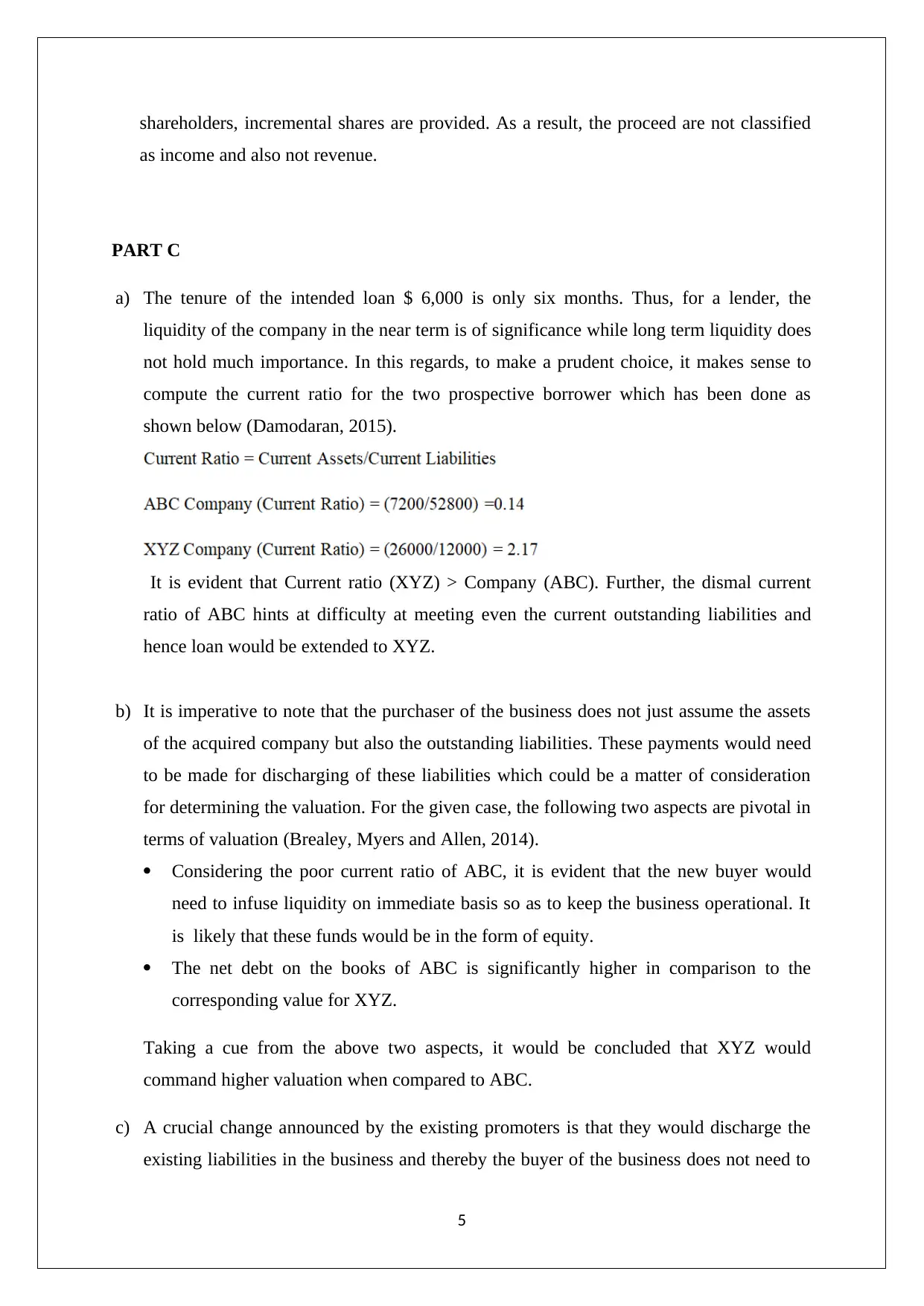
shareholders, incremental shares are provided. As a result, the proceed are not classified
as income and also not revenue.
PART C
a) The tenure of the intended loan $ 6,000 is only six months. Thus, for a lender, the
liquidity of the company in the near term is of significance while long term liquidity does
not hold much importance. In this regards, to make a prudent choice, it makes sense to
compute the current ratio for the two prospective borrower which has been done as
shown below (Damodaran, 2015).
It is evident that Current ratio (XYZ) > Company (ABC). Further, the dismal current
ratio of ABC hints at difficulty at meeting even the current outstanding liabilities and
hence loan would be extended to XYZ.
b) It is imperative to note that the purchaser of the business does not just assume the assets
of the acquired company but also the outstanding liabilities. These payments would need
to be made for discharging of these liabilities which could be a matter of consideration
for determining the valuation. For the given case, the following two aspects are pivotal in
terms of valuation (Brealey, Myers and Allen, 2014).
Considering the poor current ratio of ABC, it is evident that the new buyer would
need to infuse liquidity on immediate basis so as to keep the business operational. It
is likely that these funds would be in the form of equity.
The net debt on the books of ABC is significantly higher in comparison to the
corresponding value for XYZ.
Taking a cue from the above two aspects, it would be concluded that XYZ would
command higher valuation when compared to ABC.
c) A crucial change announced by the existing promoters is that they would discharge the
existing liabilities in the business and thereby the buyer of the business does not need to
5
as income and also not revenue.
PART C
a) The tenure of the intended loan $ 6,000 is only six months. Thus, for a lender, the
liquidity of the company in the near term is of significance while long term liquidity does
not hold much importance. In this regards, to make a prudent choice, it makes sense to
compute the current ratio for the two prospective borrower which has been done as
shown below (Damodaran, 2015).
It is evident that Current ratio (XYZ) > Company (ABC). Further, the dismal current
ratio of ABC hints at difficulty at meeting even the current outstanding liabilities and
hence loan would be extended to XYZ.
b) It is imperative to note that the purchaser of the business does not just assume the assets
of the acquired company but also the outstanding liabilities. These payments would need
to be made for discharging of these liabilities which could be a matter of consideration
for determining the valuation. For the given case, the following two aspects are pivotal in
terms of valuation (Brealey, Myers and Allen, 2014).
Considering the poor current ratio of ABC, it is evident that the new buyer would
need to infuse liquidity on immediate basis so as to keep the business operational. It
is likely that these funds would be in the form of equity.
The net debt on the books of ABC is significantly higher in comparison to the
corresponding value for XYZ.
Taking a cue from the above two aspects, it would be concluded that XYZ would
command higher valuation when compared to ABC.
c) A crucial change announced by the existing promoters is that they would discharge the
existing liabilities in the business and thereby the buyer of the business does not need to
5
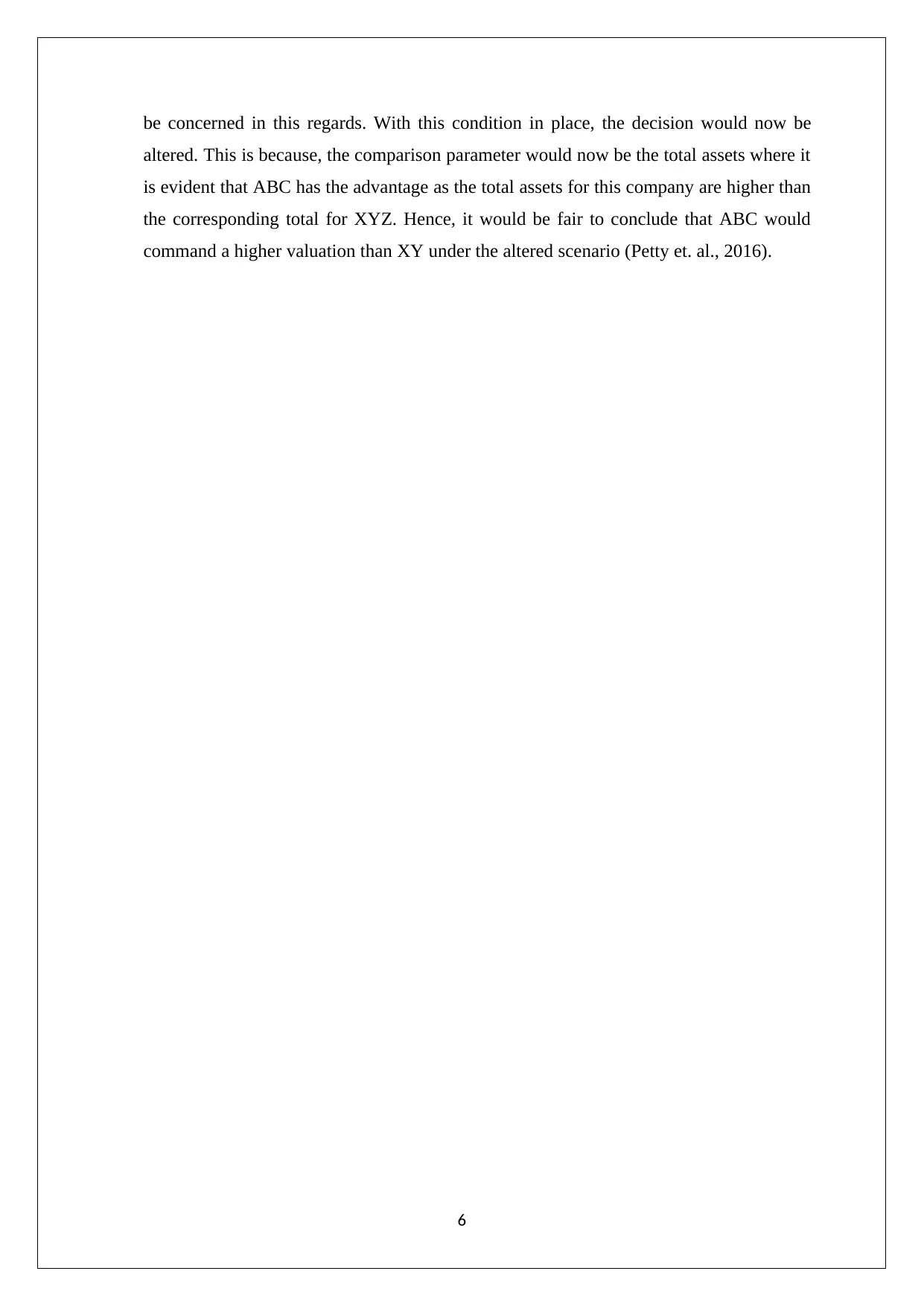
be concerned in this regards. With this condition in place, the decision would now be
altered. This is because, the comparison parameter would now be the total assets where it
is evident that ABC has the advantage as the total assets for this company are higher than
the corresponding total for XYZ. Hence, it would be fair to conclude that ABC would
command a higher valuation than XY under the altered scenario (Petty et. al., 2016).
6
altered. This is because, the comparison parameter would now be the total assets where it
is evident that ABC has the advantage as the total assets for this company are higher than
the corresponding total for XYZ. Hence, it would be fair to conclude that ABC would
command a higher valuation than XY under the altered scenario (Petty et. al., 2016).
6
⊘ This is a preview!⊘
Do you want full access?
Subscribe today to unlock all pages.

Trusted by 1+ million students worldwide

References
AASB (2014) AASB 118 – Revenue, [Online] Available at
https://www.aasb.gov.au/admin/file/content105/c9/AASB118_07-04_%20COMPapr07_07-
07.pdf [Accessed May 31 2019]
Berk, J., DeMarzo, P., Harford, J., Ford, G., Mollica, V. and Finch, N. (2016) Fundamentals
of corporate finance. London: Pearson Higher Education
Brealey, R.A., Myers, S.C. and Allen, F. (2014) Principles of corporate finance. 2nd ed. New
York: McGraw-Hill Inc
Damodaran, A. (2015) Applied corporate finance: A user’s manual. 3rd ed. New York:
Wiley, John & Sons
Lasher, W. R., (2017) Practical Financial Management. 5th ed. London: South- Western
College Publisher
Petty, J.W., Titman, S., Keown, A., Martin, J.D., Martin, P., Burrow, M., and Nguyen, H. (2016)
Financial Management, Principles and Applications. 6th ed. NSW: Pearson Education, French
Forest Australia
7
AASB (2014) AASB 118 – Revenue, [Online] Available at
https://www.aasb.gov.au/admin/file/content105/c9/AASB118_07-04_%20COMPapr07_07-
07.pdf [Accessed May 31 2019]
Berk, J., DeMarzo, P., Harford, J., Ford, G., Mollica, V. and Finch, N. (2016) Fundamentals
of corporate finance. London: Pearson Higher Education
Brealey, R.A., Myers, S.C. and Allen, F. (2014) Principles of corporate finance. 2nd ed. New
York: McGraw-Hill Inc
Damodaran, A. (2015) Applied corporate finance: A user’s manual. 3rd ed. New York:
Wiley, John & Sons
Lasher, W. R., (2017) Practical Financial Management. 5th ed. London: South- Western
College Publisher
Petty, J.W., Titman, S., Keown, A., Martin, J.D., Martin, P., Burrow, M., and Nguyen, H. (2016)
Financial Management, Principles and Applications. 6th ed. NSW: Pearson Education, French
Forest Australia
7
1 out of 7
Related Documents
Your All-in-One AI-Powered Toolkit for Academic Success.
+13062052269
info@desklib.com
Available 24*7 on WhatsApp / Email
![[object Object]](/_next/static/media/star-bottom.7253800d.svg)
Unlock your academic potential
Copyright © 2020–2025 A2Z Services. All Rights Reserved. Developed and managed by ZUCOL.





